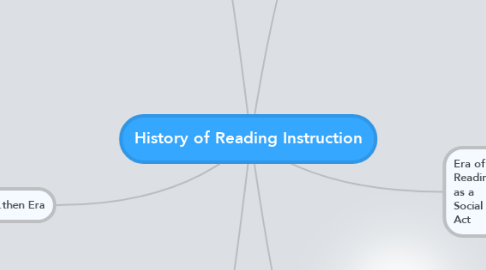
1. Era of Innate Reading Ability
1.1. Teaching Methods
1.1.1. Children can naturally learn to read
1.1.2. Can’t directly teach reaidng, students have to learn it, role of the teacher changes
1.1.3. School shouldn’t eliminate student dialect
1.1.4. Looking for “one true meaning” in text
1.1.5. Teaching of reading and writing together as Language Arts
1.2. Research & Researchers
1.2.1. Noam Chomsky: humans are “wired” to read the same way they are “wired” to learn speech
1.2.2. Roger Brown: Children actively learn rules and test them out
1.2.3. Kenneth Goodman & Frank Smith: errors that children make tell us about the inner workings of the comprehension process. Reading not something that is taught, something students learn to do.
1.2.4. William Labov, Joan Baratz, Roger Shuy: dialects not poor versions of English, distinct systems with rules
1.3. Historical & Social Context
1.3.1. Increased focus on civil rights and education of minority students
1.3.2. Cultural revolutions of late 1960s
2. Era of early reading research
2.1. Teaching Methods
2.1.1. Development of raeding assessments
2.1.2. Look-Say Approach
2.1.3. Development of readability formulas
2.1.4. Idea of readiness as necessary for learning to read
2.1.5. Focus on reading skills
2.2. Research & Researchers
2.2.1. Mitford Matthews develops words-to-letters approach, Mitford Matthews develops words to reading approach (Look-Say) where students didn’t learn to break words into letter sounds until sight words were learned
2.2.2. Edward L. Thorndike: reading assessment
2.2.3. William S. Gray: oral reading assessment
3. If...then Era
3.1. Teaching Methods
3.1.1. Increased focus on words-to reading approach
3.1.2. Over 90% of students taught with words to reading approach
3.1.3. Phonics instruction spread out over several years
3.1.4. Words in texts should be carefully controlled
3.1.5. Students as recipients of curriculum
3.1.6. Process and skills involved in reading could be broken down into parts and then mastery demonstrated (behaviorism influence)
3.1.7. Learning to read is simply acquiring reading behaviors
3.2. Research & Researchers
3.2.1. First Grade studies funded by Department of Education- compared different methods of teachign reading: anything is better than the current basals
3.2.2. Jeanne Chall: Learning the Read, the Great Debate.
3.2.3. Benjamin Bloom & John Carroll: learning mastery movement
3.2.4. Rudolf Flesh: Why Johnny Can’t Read & What You Can Do About It: attacked look-say approach
3.2.5. Skinner: behaviorism
3.3. Historical & Social Context
3.3.1. Lyndon Johnson’s Elementary and Seconday Act, 1965, Great Society
3.3.2. Creation of Title 1
3.3.3. Post WWII Baby Boom increased school-age population
4. Era of Accountability
4.1. Teaching Methods
4.1.1. Strong effects of phonics in the early grades, not much effect after that.
4.1.2. Comprehension instruction is essential
4.1.3. Emphasis on fidelity to the program
4.1.4. Data, data, data! Assess students often and then intervene based on data.
4.1.5. Reading is a combination of discrete skills and complex mental processes
4.1.6. Reading development occurs over an entire lifetime
4.2. Research and Researchers
4.2.1. National Reading Panel 2000
4.2.2. Rand Reading Study Group: Reading for Understanding: Toward an R & D Program in Reading Comprehension- reading as a long term developmental process
4.3. Historical & Social Context
4.3.1. Exponential growth of internet use, nontraditional reading becomes common
4.3.2. 2001 No Child Left Behind Act demands 100% proficiency
5. Era of Reading as a Social Act
5.1. Teaching Methods
5.1.1. Laws of text processing from previous era didn’t seem to help students
5.1.2. Focus on the group, rather than just individuals
5.1.3. Learning as a sociocultural, collaborative experience
5.1.4. Teachers as faciliators and guides
5.2. Research & Researchers
5.2.1. Research funded by National Institute Child Health and Human Development, focus on empirical research
5.2.2. Vygotsky: Constructivism
6. Era of Reading Like a Computer
6.1. Teaching Methods
6.1.1. Reading as a cognitive act
6.1.2. Emergence of literature based reading
6.1.3. Whole language comes onto the scene
6.1.4. Phonics & skills moved aside, focus on literature
6.1.5. Reading as meaning-making, not perceptual
6.1.6. Schema theory
6.1.7. Focus on the individual mind
6.2. Research & Researchers
6.2.1. Nancie Atwell: focus on students reading, reading workshop, mini-lessons
6.2.2. Donald Graves & Lucy Calkins: early writing development, workshop model
6.2.3. Rosenblatt: Transcactional theory of reading
6.3. Historical & Social Context
6.3.1. Development of computers
6.3.2. Increased funding for reading research
6.3.3. Interdisciplinary focus lauded in universities
